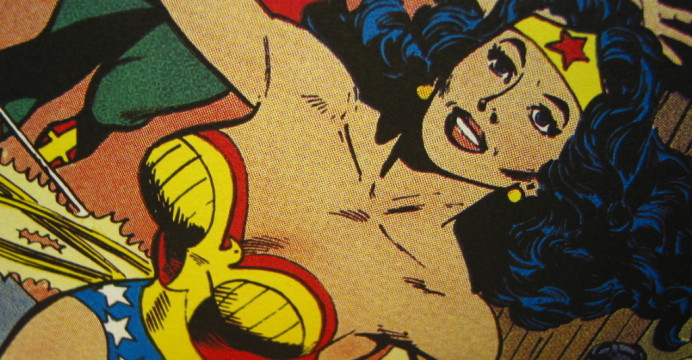[Source: Daily Iowan, Tessa Solomon, 24 March 2016]
Forget spandex, damsels, and Batmobiles. After 75 years in the superhero canon, Wonder Woman is finally breaking through the silver screen.
Batman vs. Superman: Dawn of Justice will open in theaters Friday, with Israeli actress Gal Gadot as their fiery mediator. Warner Bros. Pictures will launch Wonder Woman’s first solo live-action movie in 2017, a decades-overdue release for the lasso–whipping Amazonian.
“Superman was created in ’38, Batman in ’39, and Wonder Woman in ’41,” said UI Adjunct Assistant Professor of Slavic languages Anna Barker. “Batman and Superman have had so many cinematic iterations, but why has Wonder Woman, who is their equal age-wise, never had a film based on her?”
Barker presents an opportunity to understand Wonder Woman’s complicated history with her new undergraduate seminar, Wonder Woman Unleashed: A Hero for Our Times.
Comics held little interest for Barker as a kid; one Marvel movie turned that uninterest into fascination. Now, Barker navigates her students through an exploration of the warrior princess archetype, the symbiosis of mythology, super heroism, and, of course, the phenomenon of Wonder Woman.
To understand her status in modern times, Barker and her students begin the class 3,000 years ago.
“The mottos of Wonder Woman are peace, justice, and women’s rights,” Barker said. “What I wanted to explain to the class is that these seemingly very contemporary, feminist ideals are truly represented in the ancient world.”
That’s right; Barker doesn’t break out the comics until after the midterm. Students first delve into such Greek classics as Lysistrata, Medea, and Antigone.
“We immerse ourselves in a world thousands of years ago, where remarkably autonomous female characters existed on their own terms when women had no role outside of the family,” Barker said.
These ancient, often tragic, heroines laid the foundation for Wonder Woman. While World War II patriotism birthed Batman and Superman, psychologist William Moulton Marston had different concerns.
“Not even girls want to be girls so long as our feminine archetype lacks force, strength, and power,” wrote Wonder Woman’s creator, psychologist William Moulton Marston, in a 1943 issue of The American Scholar.
Feminine and independent, the women’s rights movement was drawn to her ideals.
“That’s what made Wonder Woman an enduring cultural phenomenon; not necessarily the fact that she was a fighter for American values during World War II,” Barker said. “She evolved into a symbol for strong femininity for generations of women.”
Already on the battlefield, another damsel would have been useless to second-wave feminists.
“Women I encounter talk about the ’60s and ’70s through the prism of their affinity to the concept of a sublimely autonomous and highly accomplished woman who gets to play the game with her own set of rules,” Barker said.
Between combating stereotypes on the press tour and shouldering the devotion of generations of women, Gadot plays by her own rules.
“You don’t fight blatant sexism with a fainting spell; you just punch,” Barker said.

